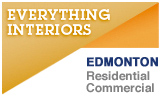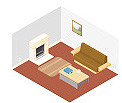residential and commercial painters.
Creating picture perfect living spaces for over 20 years.
An Overview of Different Household Paint Types
The following guide takes a look at the most common household paint types. This will help you better understand and communicate with your professional painter or contractor.
Matt Emulsion
Emulsion is the most common type of paint used for walls and ceilings and other porous surfaces. It dries quickly and typically only needs to be applied in two coats to get a perfect cover. Since emulsion is a water-based paint, it is also relatively easy to clean provided that you deal with any spills before it dries.
There are different types of emulsion offering varying textures and finishes. There are also ones which are better suited to more humid environments such as bathrooms and kitchens. Standard emulsions are often not easy to clean and are best used in low traffic areas of your home. For rooms such as kitchens or bathrooms, it is often better to go for vinyl silk emulsion since this is much easier to clean with a damp cloth. For painting ceilings, you can also go for a special non-drip emulsion as this makes painting ceilings a much cleaner and less hazardous process.
Eggshell
Eggshell paints are suitable for interior walls as well as wooden surfaces. Although oil-based rather than water-based, eggshell paints have much the same type of finish. The main advantage afforded by this type of paint is that it is much more resilient than emulsion, making it more suitable in the busiest areas of the house such as entrance ways and corridors. On the other hand, eggshell paints are also less environmentally-friendly and take longer to dry than emulsions.
Gloss
Hence its name, gloss gives a shiny, glossy finish to the surfaces it's applied on. It may either be water- or solvent-based. The former presents the advantage of being better for the environment and easier to clean when spilled, although it does not have quite such a shiny finish as solvent-based gloss does. Gloss is available for both interiors and exteriors and it is most commonly used to paint woodwork and metalwork. It is usually the paint of choice for things like windows, doors and other wooden fixtures inside the home. Gloss does present the disadvantage of taking a long time to dry. There are many different products available, however, including non-drip gloss and gloss which combines the undercoat with the topcoat. This is ideal for saving time, although it does not provide the same level of protection.
Varnish
Varnish is most often made from a resin such as shellac or tree sap. This transparent finish is primarily used on wooden surfaces to bring out and enhance the natural colour of the wood. Wooden furniture and floors are often varnished. Varnish also protects surfaces and makes them glossy and shiny. Varnished surfaces are also easy to clean. Varnish and similar products such as oils take a while to dry and often need to be applied over two or three coats to ensure adequate protection.
Undercoats and Primers
Many finishing paints require an undercoat to adhere to. While emulsion and eggshell paints may be applied to bare plaster surfaces, paints such as gloss need to be applied to a surface which has been given an undercoat (unless you get a special all-in-one product. Undercoats should not be confused with primers, however. Undercoats are designed to make the surface smoother and provide a surface for the topcoat to stick to. Primers are designed to serve as a barrier between the surface and the topcoat. As a general rule, primer needs to be used on completely new surfaces. Afterwards, an undercoat should be applied, followed by topcoat. If the surface already has some paint on it, then an undercoat is usually adequate.
Exterior Paints
You cannot use emulsion on exterior surfaces – it will barely last a day. For exterior walls, you need masonry paint. Often water-based as well, masonry paint is hardier in the face of strong weather and should last for between five and ten years before another coat is advisable. Masonry paint comes in smooth and textured forms and needs to be applied on rendered surfaces with two or three coats.
Choosing Color
Having difficulties finding the right color for your space? Read our guide in how to select best color for your house or a condo.
By phone: 780 498 0424
Email:services@everythinginteriors.ca
Address:15231 63StEdmonton, Alberta
T5A 4V8 Canada



